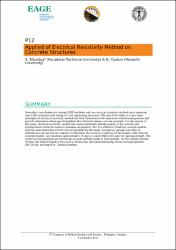Applied of Electrical Resistivity Method on Concrete Structures

View/
Access
info:eu-repo/semantics/restrictedAccessDate
2011Access
info:eu-repo/semantics/restrictedAccessMetadata
Show full item recordAbstract
Nowadays, non-destructive testing (NDT) methods such as electrical resistivity method plays important role in the evaluation and testing of civil engineering structures. The aim of the study is to give basic principles of electrical resistivity method and their limitations in the structural evaluation programme and provide information about agreed standards that obtained various concrete materials. For this reason, in this study, electrical resistivity method was used to determine that the quality of the concrete and reinforcement within the concrete situation and position. The five different cylindrical concrete models with the same dimension (15x30 cm) are prepared for this study. Iron pieces, sponges and rebar in different size are put into the concrete to determine the resistivity responses of the models. After that, the concrete models are incubated approximately 21 days in a tank filled with water for gaining strength. The resistivity measurements are carried out on each cylinder model in three profiles. On the cylinder models, Wenner and Dipole-Dipole arrays used to obtain data, and interpreted using 2D inversion programme (DC2dTree, developed by Thomas Günther).

















